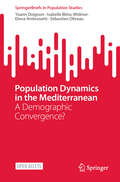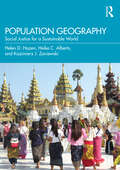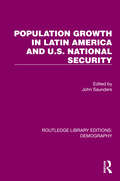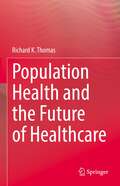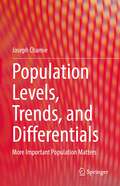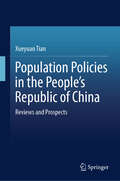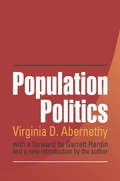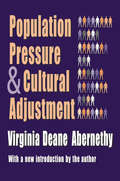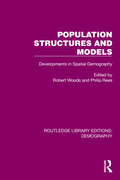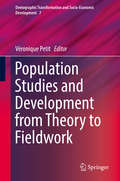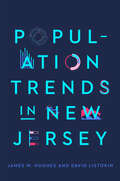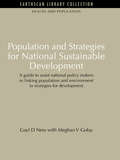- Table View
- List View
Population Dynamics in the Mediterranean: A Demographic Convergence? (SpringerBriefs in Population Studies)
by Elena Ambrosetti Isabelle Blöss-Widmer Sébastien Oliveau Yoann DoignonThis open access book makes a comparative overview of the demographic evolution of the Mediterranean populations. It addresses all the demographic issues since 1950 such as fertility, mortality, growth, demographic aging, and the age structure of the population. The book discusses the major demographic changes and its consequences for the Mediterranean region and describes the socio-economic and societal opportunities such as the silver economy, improvement in health of the population, and progress in education. By providing insights into the past demographic evolutions and analyzing the most recent indicators, this book constitutes an essential reference work for those who wish to better understand the major transformations that Mediterranean societies are undergoing.
Population Genomics with R
by Emmanuel ParadisPopulation Genomics With R presents a multidisciplinary approach to the analysis of population genomics. The methods treated cover a large number of topics from traditional population genetics to large-scale genomics with high-throughput sequencing data. Several dozen R packages are examined and integrated to provide a coherent software environment with a wide range of computational, statistical, and graphical tools. Small examples are used to illustrate the basics and published data are used as case studies. Readers are expected to have a basic knowledge of biology, genetics, and statistical inference methods. Graduate students and post-doctorate researchers will find resources to analyze their population genetic and genomic data as well as help them design new studies. The first four chapters review the basics of population genomics, data acquisition, and the use of R to store and manipulate genomic data. Chapter 5 treats the exploration of genomic data, an important issue when analysing large data sets. The other five chapters cover linkage disequilibrium, population genomic structure, geographical structure, past demographic events, and natural selection. These chapters include supervised and unsupervised methods, admixture analysis, an in-depth treatment of multivariate methods, and advice on how to handle GIS data. The analysis of natural selection, a traditional issue in evolutionary biology, has known a revival with modern population genomic data. All chapters include exercises. Supplemental materials are available on-line (http://ape-package.ird.fr/PGR.html).
Population Geography: A Systematic Exposition
by Mohammad Izhar HassanThis book studies the origins and development of population geography as a discipline. It explores the key concepts, tools and statistical and demographic techniques that are widely employed in the analysis of population. The chapters in this book: Provide a comprehensive geographical account of population attributes in the world, with a particular focus on India; Study the three major components of population change – fertility, mortality and migration – that have remained somewhat neglected in the study of human geography so far; Examine the salient social, demographic and economic characteristics of population, along with topics such as size, distribution and growth of population; Discuss major population theories, policies and population–development–environment interrelations, thus marking a significant departure from the traditional pattern-oriented approach. Well supplemented with figures, maps and tables, this key text will be an indispensable read for students, researchers and teachers of human geography, demography, anthropology, sociology, economics and population studies.
Population Geography: Social Justice for a Sustainable World
by Heike C. Alberts Helen D. Hazen Kazimierz J. ZaniewskiPopulation Geography: Social Justice for a Sustainable World surveys the ways in which geographic approaches may be applied to population issues, exploring how human populations are embedded in natural and social environments. It encourages students to evaluate population issues critically, given that population topics are at the heart of many of today’s most contentious subjects. Through introducing students to different lenses of analysis (ecological, economic, and social equity), the authors ask students to consider how different perspectives can lead to different conclusions on the same issue. Identifying and tackling today’s population problems therefore requires an understanding of these diverging, and sometimes conflicting, perspectives. The text covers all the key background information critical to any book on population geography (population size, distribution, and composition; fertility, mortality, and migration; population and resources) but also pushes students to think critically about the materials they have covered using the perspectives of sustainability and social justice. In this way, students move beyond simple fact learning toward higher-level skills such as analysis, synthesis, and evaluation of materials. This textbook will be a valuable resource for students of human geography, population geography, demography, and diaspora studies.
Population Growth In Latin America And U.S. National Security (Routledge Library Editions: Demography #11)
by John SaundersOriginally published in 1986, this volume deals with both population growth in Latin America and the possible consequences of this growth for the security of the USA. The text analyses the demographic dimensions of the phenomenon and then considers the consequences for US security. It was the first time that the interrelations between national security and population growth were systematically analyzed. The book predicts the raid population growth would have serious economic, social and strategic implications for the USA and rightly predicts the adoption of draconian measures to stem the flow of illegal migrants. Although some aspects of the political landscape have changed since original publication the issue of migration to the USA from Latin America has lost none of its relevance.
Population Growth and Levels of Consumption: With Special Reference to Countries in Asia (Routledge Library Editions: Demography #1)
by Belshaw HoraceOriginally published in 1956, this book considers the practical problems of economic development in countries in which the prevailing outlook and a recent or probable increase in population growth make it difficult to escape from a ‘Malthusian situation.’ This book develops a valuable analytical apparatus with which it then examines the problems of capital formation, investment, economies of scale and the effective supply of labour, all in relation to population growth. Social, institutional and cultural factors are integrated with the economic.
Population Growth: The Vital Revolution
by Ronald FreedmanThe population of the modern world continues to grow at a rate unprecedented in human history. How are we to explain this massive increase in the number of living people? What is its consequence, now and for the future? How have populations changed in size and structure since the advent of industrial technology? Can we predict the population trends in developing countries? These and many other significant questions are dealt with in a persuasive yet accessible manner in Ronald Freedman's pivotal "Population Growth".Modern population trends are unique in historical perspective; describing them as part of a "vital revolution" is not an exaggeration. The more popular term "population explosion" is less accurate because it refers to only one aspect of the current situation - the unprecedented growth rates. In the last two centuries other important trends have developed, also without precedent in all of the previous millennia of human history. While the size of population growth is very important in itself, the essays in this volume demonstrate that many other aspects of structure and change in populations are equally important.In readable, non-technical language, these collected essays analyze the most important modern trends in world population. The essays include comprehensive discussions of population theory, analyses of population trends, and prospects in the United States and surveys of population trends in other major areas of the world. As a survey of current population problems, this book will be a library staple for those involved in international development programs, sociologists, family planning workers, and everyone concerned with the contemporary vital revolution in population.
Population Health and the Future of Healthcare
by Richard K. ThomasStarting with a working definition, this comprehensive work defines the attributes of the population health model. It clarifies what population health is and is not. It discusses health disparities and the social determinants of health and illness and provides new ways of moving forward towards a more sustainable healthcare model in a changing society, thereby pointing out the importance of multi-sector collaboration for collective impact for community health improvement. The book takes this further by providing sources of data to support the population health model. As such, this book provides a must-read for students and anyone working, teaching or consulting in population healthcare.
Population Health: An Introduction (Springer Texts in Social Sciences)
by Richard K. ThomasThis book provides a basic understanding and concise overview of the nature of population health, the factors that make a new paradigm necessary, and the attributes associated with this unique approach to community health improvement. Written in a very accessible way, the book describes the definition of population health, the attributes of population health, and what population health is and is not. It emphasizes the extent to which the population health model revolutionizes the approach to community health improvement within a contemporary context, beginning with a redefining of such common concepts as “health”, “healthcare”, “health status”, and “health needs assessment”. As such, this book is a valuable read for practitioners and professionals who need to be familiar with the population health approach but are not likely to try to implement it.
Population Levels, Trends, and Differentials: More Important Population Matters
by Joseph ChamieThis book is a broad collection of short and concise chapters addressing important issues relating to population levels, trends, and differentials. In addition to traditional population concerns, such as growth, composition, fertility, mortality, and migration, the articles address a broad range of related issues, including climate change, environmental degradation, socio-economic development, and policy development. The articles are concise, focused on specific issues, and presented in a style that avoids technical jargon and is easily understood by a broad range of readers. The articles are not only aimed at conveying population information, but also providing important messages for informed policy formulation and program implementation. Among the many issues addressed are human rights, laws, women, gender, climate change, COVID-19 pandemic, ageing, retirement, and abortion. Written in an accessible way, the book will appeal to many general readers wishing to know more about population issues.
Population Policies in the People’s Republic of China: Reviews and Prospects
by Xueyuan TianFrom an insider&’s perspective, this book elaborates on the three stages of population policies since the founding of the People&’s Republic of China (PRC). As a key policy discussant and drafter, the author incorporates some valuable documentaries and manuscripts that have not been revealed in the extant literature and brings in new theoretical angles for interpretations of population policies in the PRC. This book begins with a brief review of population policies in ancient China and then focuses on the population debates and growing concerns for population growth in the first thirty years of the PRC. This is followed by telling the whole story of the PRC&’s one-child policy, including theoretical discussions, the policy&’s situated social context, policy details, and strategies. Lastly, this book discusses the population changes and trends in the twenty-first century and provides advice on China&’s population development strategies in the future. Throughout the book, the author draws on his own experience in population policy-making to provide new insights in his review of China&’s one-child policy and facilitates a delineation of population changes among social developments, population debates, and government policy changes. This book is intended for readers who are interested in population policies of the PRC. It is particularly useful for students and researchers specializing in China&’s population studies and serves as a trustworthy source for those wanting a holistic picture of the PRC&’s population policies.
Population Politics: The Choices That Shape Our Future
by Virginia Abernethy Garrett HardinInternational efforts to regulate fertility rates so that populations do not grow beyond the earth's capacity have included technical assistance and capital; improved health care conditions to lower the risk of infant mortality; increased opportunities to develop literacy; the democratization of governments; and several decades of liberal immigration and refugee policies favoring third world nations. The persistence of high fertility despite international efforts confounds demographers. 'Population Politics' brilliantly dissects the paradigm responsible for the counterproductive efforts of nations and international agencies. Abernethy, a renowned anthropologist, shows why policies hamper the shift to lower fertility. Ireland, Indonesia, Cuba, China, Turkey and Egypt are but a few of the countries Abernethy examines, showing how economic, sociocultural, and agricultural factors that have caused population growth can be harnessed to stabilize population size. 'Population Politics' is a provocative examination of the influence of aid and liberal immigration policies on world population growth, and often counterproductive to the role of the United States as an industrial power. This volume's uniquely interdisciplinary perspective will enlighten the lay reader, as well as demographers and epidemiologists, conservationists, reproduction and family specialists, agricultural economists, and public health personnel. Virginia D. Abernethy is professor emeritus of psychiatry (anthropology) at Vanderbilt Medical School and was for 11 years the editor of the scholarly journal 'Population and Environment. Garrett Hardin is emeritus professor of human ecology in the Department of Biological Sciences and the University of California, Santa Barbara.
Population Pressure and Cultural Adjustment
by Virginia Deane AbernethyIntegrating research from anthropology, biology, and history, this provocative, brilliant book proposes a theory of demographic equilibrium. The author's hypothesis is that human beings, like many other species, are able to adjust their population numbers to the carrying capacity of the environment. Abernethy points out that in response to perception of scarcity or abundance of resources, culturally mediated values, beliefs and behavioral patterns are modified in ways that can either raise or lower rates of population growth. Abernethy in this way moves beyond the ideological debates that have sundered the field of policy and population. In real world time and space, cultural adjustments that balance population and resources are made over a long stretch in relatively stable or known environments. These adjustments also operate in processes that involve technological advances that appear to increase carrying capacity, and these usually act to support and underwrite population growth in any given area. In her new introduction to this first paperback edition, Abernethy shows how many of the cultural changes the book predicted in 1979 have come to pass. She details a complex of behaviors that favor single life-styles or small family size that have contributed to low fertility rates among native-born Americans while fertility rates among immigrants continue to climb. Population Pressure and Cultural Adjustment is not simply a theoretical slogan, but discusses a rich set of different cultural situations where this homeostatic process has been disrupted or aborted. Often, disruption occurs after the infusion of foreign value systems as well as new forms of technological innovation, or when highly permeable social boundaries result in the importation of resources for which the limits and consequences are not fully appreciated by the host population. This work will inevitably be controversial because of its implications for the limits as well as the potential of public policy in both advanced and underdeveloped societies.
Population Reconstruction
by Gerrit Bloothooft Peter Christen Kees Mandemakers Marijn SchraagenThis book addresses the problems that are encountered, and solutions that have been proposed, when we aim to identify people and to reconstruct populations under conditions where information is scarce, ambiguous, fuzzy and sometimes erroneous. The process from handwritten registers to a reconstructed digitized population consists of three major phases, reflected in the three main sections of this book. The first phase involves transcribing and digitizing the data while structuring the information in a meaningful and efficient way. In the second phase, records that refer to the same person or group of persons are identified by a process of linkage. In the third and final phase, the information on an individual is combined into a reconstruction of their life course. The studies and examples in this book originate from a range of countries, each with its own cultural and administrative characteristics, and from medieval charters through historical censuses and vital registration, to the modern issue of privacy preservation. Despite the diverse places and times addressed, they all share the study of fundamental issues when it comes to model reasoning for population reconstruction and the possibilities and limitations of information technology to support this process. It is thus not a single discipline that is involved in such an endeavor. Historians, social scientists, and linguists represent the humanities through their knowledge of the complexity of the past, the limitations of sources, and the possible interpretations of information. The availability of big data from digitized archives and the need for complex analyses to identify individuals calls for the involvement of computer scientists. With contributions from all these fields, often in direct cooperation, this book is at the heart of the digital humanities, and will hopefully offer a source of inspiration for future investigations.
Population Since the Industrial Revolution: The Case of England and Wales (Routledge Library Editions: Demography #13)
by Neil TranterOriginally published in 1973, this book is an introduction to the study of population history since the Industrial Revolution and focuses on the experience of England and Wales. It provides both a comprehensive survey of the vast array of specialist literature and a thorough explanation of the sources and methodology of historical demographic analysis. Throughout special emphasis is given to the need to recognise that the historical pattern of population growth in England and Wales has been broadly similar to that observed elsewhere in Western Europe. The sources and techniques of historical demography are discussed and the general outline of population growth between 1688 and 1939 examined. The factors responsible for the dramatic increase in population growth during the late 18th and 19th Centuries are analysed as are the causes of the abrupt down-turn in rate of population following World War 1. The part played by population change in the development of the British economy and the impact of population change on society are also covered. By integrating the social and economic impact of population change with sources and methods, this text fills a gap and will be of essential reading to students in economics, sociology and social history.
Population Structures and Models: Developments in Spatial Demography (Routledge Library Editions: Demography #14)
by Robert Woods Philip ReesOriginally published in 1986, this volume brings together geographical modelling of population change and demographic analysis of population structures and pattern. These 2 strands are interwoven in 3 key review chapters that summarize the study of spatial and temporal patterns of population, the modelling of spatial populations and the estimation of population processes. Findings reported include: An account of demographic transition; an exposé of the myth of ‘no fertility rises’ in the developing world in the 20th Century; a theory of population accounting; predicting migration flows for a system of regions; microsimulation methods to model population change; and demographic and economic processes integrated in an urban region model.
Population Studies and Development from Theory to Fieldwork
by Véronique PetitThis book addresses major population and development issues: fertility and reproductive health, migrations, gender, education, poverty and inequalities. To that aim it revisits and considerably enlarges Kingsley Davis’ 1963 theory of change and response, using interdisciplinary methodologies. On the basis of four decades of field research (1985-2015), it questions the rationality of the actors, how culture shapes socio-demographic behaviours, in a context of modernity and globalisation. More specifically, it casts new light on the interactions of individuals, families, networks and local communities with the State and its population policy.
Population Studies in the Western Balkans (European Studies of Population #26)
by Christos Skiadas Konstantinos N. Zafeiris Byron KotzamanisThis book is a collection of scientific studies regarding the biological, economic, historical, health, social, and other aspects of the populations of the western Balkans, a geographic area with distinct as well as diverse socioeconomic backgrounds, political systems, ethnic characteristics, development, and history. Through providing data analyses, statistical methodologies, and important applications, the book addresses and explores topics such as temporary migration and human resource availability, depopulation, and the immigration future, returning migrants, poverty, population dynamics and birth rate trends, reproduction and family creation, aging, mortality and health developments, and much more. As such, this book is of great importance in understanding the mechanisms of population change and dynamics in an European area and provides a valuable guide for researchers, policy makers, and practitioners from various disciplines.
Population Trends in New Jersey
by David Listokin James W. HughesTo fully understand New Jersey in the 2020s and beyond, it is crucial to understand its ever-changing population. This book examines the twenty-first century demographic trends that are reshaping the state now and will continue to do so in the future. But trend analysis requires a deep historical context. Present-day New Jersey is the result of a long demographic and economic journey that has taken place over centuries, constantly influenced by national and global forces. This book provides a detailed examination of this journey. The result is present-day New Jersey. The authors also highlight key trends that will continue to transform the state: domestic migration out of the state and immigration into it; increasing diversity; slower overall population growth; contracting fertility; the household revolution and changing living arrangements; generational disruptions; and suburbanization versus re-urbanization. All of these factors help place in context the result of the 2020 decennial U.S. Census. While the book focuses on New Jersey, the Garden State is a template of demographic, economic, social, and other forces characterizing the United States in the twenty-first century.
Population and Development Issues
by Yves CharbitOne of the major challenges facing the world today is the interaction between demographic changes and development. Rather than the usual view that the population itself is the main problem, Population and Development Issues argues that it is just one factor among many others, such as poverty, illiteracy, poor health, unemployment, the condition of women and climate change.This book analyzes the relationships between the key demographic variables (fertility, morbidity and mortality, migration, etc.) and major development issues, notably education, employment, health, gender, social and geographical inequalities and climate concerns. Bringing together contributions from specialists across every field, it presents empirical data simply and clearly alongside theoretical reflections.
Population and Health in Developing Countries
by Maryse GaimardThis book provides an overview of the health of developing nations in the early twenty-first century. The basic assumption is that the health of a population is not independent of broader demographic trends, and does follow the health transition model. The coverage is broad, ranging from health transition in developing countries, to the health of women, to an analysis of morbidity. Population health is an essential component of human and social development. As both a means and an end of development, health lies at the heart of underdevelopment, and ranks first on the list of international priorities. The WHO slogan 'Health for all in 2000' reflects the spirit of a more general movement in favor of health promotion throughout the world. But the developing world is far from reaching this aim. The health of populations has improved in developing regions but there are still deep inequalities, and serious problems remain, especially in Sub-Saharan Africa. After reviewing the core concepts of population health, the book examines health transition in developing countries, a process that has resulted in a double burden of diseases. A discussion of mortality in developing countries serves to highlight the high rates of child mortality in these regions. The book devotes a full chapter to women's health, and its chapter-length analysis of morbidity highlights the double burden weighing down developing populations and concludes with an analysis of health systems in developing countries.
Population and Society
by Dudley L. Poston Leon F. BouvierPopulation and Society: An Introduction to Demography is an ideal text for undergraduate, as well as graduate, students taking their first course in demography. It is sociologically oriented, although economics, political science, geography, history, and the other social sciences are also used to inform the materials. Although the emphasis is on demography, the book recognizes that, at the individual level, population change is related to private decisions, especially in relation to fertility, but also to mortality and migration. The text thus considers in some detail the role of individuals in population decision making. At the level of countries, and even the world, changes in population size have an important effect on the environmental and related challenges facing all of the world's inhabitants. Therefore, attention is paid to the broad implications of population growth and change.
Population and Strategies for National Sustainable Development: Population and Strategies for National Sustainable Development (Health and Population Set)
by Gayl D Ness Meghan V GolayFirst Published in 2009. Routledge is an imprint of Taylor & Francis, an informa company.
Population and Sustainable Development in India
by Aalok Ranjan ChaurasiaThis book addresses central issues related to population and sustainable development in India, the second most populous country in the world. Using the latest available source of data in the context of the United Nations 2030 Sustainable Development Agenda, it analyzes the current state of development in India in terms of economic growth, social inclusion, and environmental protection, especially focusing on the role of population. The respective chapters explore various aspects, but mainly focus on promoting greater sustainability in terms of population growth, child survival, and economic growth. As such, the book will be of interest to students, researchers, and policymakers in the fields of population studies, economics, and international development.
Population and the Political Imagination: Census, Register and Citizenship in India
by R.B. BhagatThis book identifies population as a central issue of polity and examines its links to ideas of state and citizenship. It explores the relationship between the state, citizenship and polity by reexamining processes related to census enumeration, population and citizen registers, and the politics of classificatory governmentality. Religion, ethnicity, caste and political class play a key role in determining community identities and the relationship between an individual and the state. Contextualizing the arguments and controversies around the Citizenship (Amendment) Act 2019 (CAA 2019) and the National Register of Citizens (NRC), the book examines the processes of inclusion or exclusion of minorities and migrants as citizens in India. It focusses on the classification of irregular and refugee migration since independence in India, especially in the state of Assam. The book highlights how political imagination, as a theoretical framework, shapes the processes and strategies for enumeration and classification and thereby the idea of citizenship. Underlining the relationship between instruments of government, political mobilization and the resurgence of communal polarization, it also offers suggestions for alternative constructions of citizenship and an inclusive state. This book will be useful for students and researchers of population studies, population geography, migration studies, sociology, political science, social anthropology, law and journalism. It will also be of interest to policy makers, journalists, as well as NGOs and CSOs.
